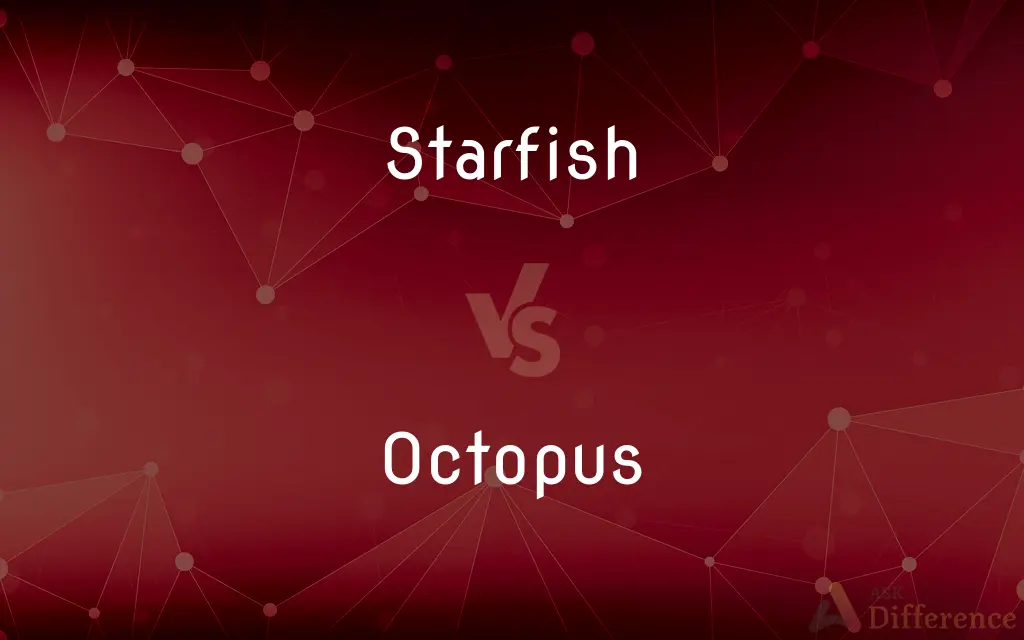Starfish vs. Octopus — What's the Difference?
By Tayyaba Rehman & Maham Liaqat — Updated on March 28, 2024
Starfish have radial symmetry and thrive on the ocean floor, whereas octopuses, with bilateral symmetry, are more versatile in movement and habitat.

Difference Between Starfish and Octopus
Table of Contents
ADVERTISEMENT
Key Differences
Starfish, or sea stars, are marine invertebrates known for their star-shaped body and radial symmetry, meaning their body parts are arranged around a central axis. Octopuses, on the other hand, are also marine invertebrates but belong to the class Cephalopoda.
While starfish feed primarily by external digestion, prying open mollusks and secreting digestive enzymes to liquefy their prey before sucking up the resulting soup, octopuses have a more aggressive approach. They use their arms and suckers to capture prey, pulling it towards their beak-like jaws for consumption. Octopuses are known for their varied diet, which can include crabs, shellfish, and even small fish.
Starfish and octopuses also exhibit remarkable defensive strategies. Starfish can regenerate lost arms, a capability that doubles as a defense mechanism against predators. Some species can also eject their stomach to evade threats. Octopuses, known for their intelligence, employ a range of tactics, including camouflage, squirting ink to obscure attackers' view, and mimicking other sea creatures to avoid detection.
Comparison Chart
Body Symmetry
Radial symmetry
Bilateral symmetry
Movement
Slow, using tube feet
Swift, using jet propulsion and arm crawling
ADVERTISEMENT
Feeding
External digestion of mollusks
Uses beak to eat crabs, shellfish, and fish
Defense Mechanism
Regeneration of arms, stomach ejection
Camouflage, ink squirting, mimicry
Compare with Definitions
Starfish
Feeds by external digestion.
The starfish wrapped around the clam, slowly secreting digestive enzymes.
Octopus
Uses ink as a defense mechanism.
Threatened, the octopus released a cloud of ink, escaping under cover.
Starfish
Known for radial symmetry.
Each arm of the starfish perfectly mirrors the others, showcasing radial symmetry.
Octopus
Exhibits bilateral symmetry.
The octopus's body is divided into two symmetrical halves, displaying bilateral symmetry.
Starfish
Marine invertebrates with a star-shaped body.
The tide pool was teeming with starfish clinging to the rocks.
Octopus
Cephalopods with eight arms.
The octopus camouflaged itself among the coral, its eight arms barely visible.
Starfish
Moves using tube feet.
The starfish slowly advanced across the aquarium glass, its tube feet pulsating gently.
Octopus
Known for sophisticated behaviors.
The octopus solved the puzzle, unlocking the container to access food.
Starfish
Can regenerate lost arms.
After losing an arm to a predator, the starfish gradually grew a new one.
Octopus
Demonstrates remarkable problem-solving skills.
Using its tentacles, the octopus figured out how to open the jar.
Starfish
Starfish or sea stars are star-shaped echinoderms belonging to the class Asteroidea. Common usage frequently finds these names being also applied to ophiuroids, which are correctly referred to as brittle stars or basket stars.
Octopus
Any member of the genus Octopus.
Starfish
A marine echinoderm (invertebrate) with five or more radiating arms. The undersides of the arms bear tube feet for locomotion and, in predatory species, for opening the shells of molluscs.
Octopus
Octopus (pl. octopuses, see below for variants) are soft-bodied, eight-limbed molluscs of the order Octopoda (, ok-TOP-ə-də).
Starfish
Any of various marine echinoderms of the class Asteroidea, characteristically having a thick, often spiny body with five arms extending from a central disk. Also called asteroid, sea star.
Octopus
Any of various carnivorous marine cephalopod mollusks chiefly of the family Octopodidae, having a soft body, eight arms with suckers, a large distinct head, and a mouth with a strong beak.
Starfish
Any of various asteroids or other echinoderms (not in fact fish) with usually five arms, many of which eat bivalves or corals by everting their stomach.
Octopus
Something, such as a multinational corporation, that has many powerful, centrally controlled branches.
Starfish
(obsolete) Any many-armed or tentacled sea invertebrate, whether cnidarian, echinoderm, or cephalopod.
Octopus
Any of several marine molluscs of the family Octopodidae, having no internal or external protective shell or bone (unlike the nautilus, squid and cuttlefish) and eight arms each covered with suckers.
Starfish
The anus. Category:en:Pornography
Chocolate starfish
Octopus
(uncountable) The flesh of these marine molluscs eaten as food.
Starfish
(intransitive) To assume a splayed-out shape, like that of a starfish.
Octopus
An organization that has many powerful branches controlled from the centre.
Starfish
(transitive) To form into a splayed-out shape, like that of a starfish.
Octopus
To put (or attempt to put) one's fingers, hands or arms in many things or places at roughly the same time.
Starfish
Any one of numerous species of echinoderms belonging to the class Asterioidea, in which the body is star-shaped and usually has five rays, though the number of rays varies from five to forty or more. The rays are often long, but are sometimes so short as to appear only as angles to the disklike body. Called also sea star, five-finger, and stellerid.
Octopus
To spread out in long arms or legs in many directions.
Starfish
The dollar fish, or butterfish.
Octopus
To plug a large number of devices into a single electric outlet.
Starfish
Echinoderms characterized by five arms extending from a central disk
Octopus
(by extension) To grow in use vastly beyond what was originally intended.
Octopus
To hunt and catch octopuses.
Octopus
To behave like an octopus.
Octopus
A genus of eight-armed cephalopods, including numerous species, some of them of large size. See Devilfish.
Octopus
Something resembling an octopus in having numerous controlling arms or branches that reach widely and influence many activities; - used mostly of organizations, such as diversified corporations.
Octopus
Tentacles of octopus prepared as food
Octopus
Bottom-living cephalopod having a soft oval body with eight long tentacles
Common Curiosities
How do octopuses change color?
Octopuses change color using specialized skin cells called chromatophores, which expand or contract to alter their appearance.
Are starfish considered fish?
Despite their name, starfish are not fish but echinoderms, closely related to sea urchins and sand dollars.
How do starfish move?
Starfish move using hundreds of tiny tube feet that operate through hydraulic pressure.
Do starfish have a brain?
Starfish do not have a brain; instead, they have a simple nervous system that coordinates their movements.
What is the primary habitat of starfish?
Starfish primarily reside on the ocean floor, especially in coral reefs and rocky shores.
What kind of intelligence do octopuses display?
Octopuses show advanced problem-solving abilities, can use tools, and have short- and long-term memory.
What defenses do octopuses have against predators?
Octopuses can camouflage, squirt ink, and even mimic other sea animals as defense mechanisms against predators.
Can starfish and octopuses regenerate body parts?
Starfish can regenerate lost arms, and under certain conditions, octopuses can regrow parts of their arms.
How do starfish eat?
Starfish eat by enveloping their prey, usually mollusks, and externally digesting it with enzymes before sucking in the liquefied nutrients.
Can octopuses feel pain?
Yes, octopuses can feel pain, responding to injury or harm with immediate actions to avoid or mitigate the source of pain.
Are all starfish able to regenerate?
Most starfish can regenerate lost limbs, and some can regenerate an entirely new body from a portion of a severed limb.
What is the lifespan of an octopus?
The lifespan of an octopus varies by species, ranging from one to several years.
What environmental role do starfish play?
Starfish play a crucial role in marine ecosystems, often acting as keystone predators that help maintain the balance of marine life populations.
How do octopuses navigate their environment?
Octopuses use a combination of vision, touch, and a keen sense of chemical detection to navigate their environment.
Share Your Discovery

Previous Comparison
Mania vs. Phobia
Next Comparison
Incineration vs. PyrolysisAuthor Spotlight
Written by
Tayyaba RehmanTayyaba Rehman is a distinguished writer, currently serving as a primary contributor to askdifference.com. As a researcher in semantics and etymology, Tayyaba's passion for the complexity of languages and their distinctions has found a perfect home on the platform. Tayyaba delves into the intricacies of language, distinguishing between commonly confused words and phrases, thereby providing clarity for readers worldwide.
Co-written by
Maham Liaqat













































